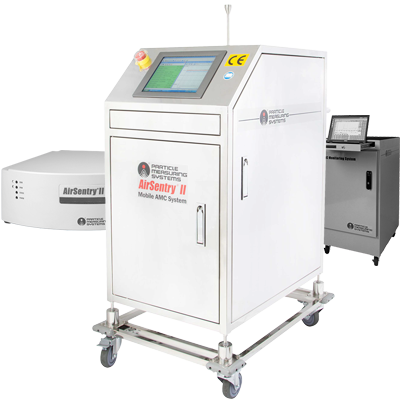Time for a new blog series! Here, we discuss the benefits of airborne contamination monitoring (AMC) in photolithography (lithography)
Real-Time Airborne Molecular Contamination (AMC) Monitoring in Lithography: Why It’s Needed
Making photolithography masks, reticles, and other precision optical components defect-free and surface-contaminant-free is the ultimate goal of lithography (“litho”) and metrology functional areas within microelectronics manufacturing. There’s a need for real-time Airborne Molecular Contamination (AMC) monitoring within these industries wherever optical components are manufactured and used for actinic or inspection purposes. The solution? Ion Mobility Spectrometry (IMS) using Particle Measuring Systems‘ AirSentry® II (ASII) Real-time AMC Analyzer within the litho, metrology, and photo optical lens manufacturing areas.
Where do the defects occur?
Reduction of feature defects is a core interest of the The International Roadmap for Devices and Systems (IRDS 2020 Edition).
- Specifically, defects originating from patterned images transferred to the wafer in the photolithography functional area (litho FA) using advanced lithography techniques.
Developer and scanner processes in the litho FAs are included, but another point of use for AMC monitoring is where any high precision optical components are used, including manufacturing of 193 nm and 266 nm lasers. The areas of focus, otherwise known as the sources of AMC contamination, can be summarized into two categories:
- The distortion of patterns emitted through the optical surfaces (masks, reticle, mirrors, lenses, and other optical components) during the exposure process in advanced litho processes.
- Stochastic defects—random time-dependent variations in light exposure and in resist chemistry that occur during the actinic exposure process step. By light exposure, we mean the number of photons in a discrete exposure of a small area and by resist chemistry, we mean the random placement, reaction and dissolution of the various molecular components that make up photoresist.
Defect group #1 is predominantly affected by:
- The presence of AMC in the litho FA, where AMC can cause surface contamination on masks and reticles and other precision optical components.
However, both defect groups can be affected by:
- Anomalies within the optical components (lenses, mirrors, waveplates, prisms, polarizers, etc.) that have been exposed to AMC during manufacturing.
Contamination on an optical component from AMC during manufacturing was found below:
What happens to the contamination?
Once assembled into the linked litho scanner toolset, components with hidden anomalies can lead to distorted light pattern emission. The Extreme Ultra Violet (EUV) process tool uses reflective optical components for projecting the pattern directly onto the wafer in a vacuum environment and must:
- Minimize wavefront distortion
- Where applicable, not limit the ability to properly focus the beam at the wafer surface
If embedded anomalies exist in these precision optical components, they will eventually reduce or limit the quality of the image on the wafer. AMC and its products can settle on optical surfaces during manufacturing, packaging, or transport, becoming the root cause of embedded reflective optical component defects (EUV), and transmissive optical component defects (DUV and previous generation).
AMC-related surface contamination and faulty optical components with embedded AMC-related defects are not only a concern for the Litho FA and Litho Tool OEM assembly, but are also a major concern in the inspection tool Metrology FA and Metrology tool OEM assembly. Both Litho and Metrology tool OEMs require the manufacture and delivery of near-perfect light transmission performance from their respective optical component and sub-system supply chains.
Can the defects be reduced with Real-time AMC Monitoring in Lithography?
Slower resist formulas have been shown to reduce some stochastic defects. However, the time-dependent defects associated with AMC exposure (in DUV and previous generations) will also increase proportionally due to the longer expose process and pre-expose queue times. Furthermore, defects are predicted to increase if AMCs are present during the longer exposure times required when implementing more complex DUV, DUV-double and even DUV-quadruple patterning schemes needed per IRDS 2020.
 What to Take Away
What to Take Away
- The successful implementation of advanced litho techniques has meant that the roadmap’s major challenges are no longer resolution dependent on light wavelength.
- Major challenges will come from the transmission of unaltered light patterns passing through various optical components and sub-systems within a litho tool, and the optimal performance of the photo resist material to minimize overlay, critical dimension (CD), and Line Edge Roughness (LER) defects.
- The same concern for optical components in the litho FA should also be extended into the adjacent metrology functional areas where high power and density (focus) DUV lasers are used.
- Precision optical components and sub-system (including DUV lasers) manufacturing areas will need tighter control of AMC standards than traditional litho FAs.
Want to learn more about how to limit AMCs in your lithography application?
Learn more… Get the full paper here.
Do you work in the Lithography, Metrology, and Component (Sub-System) Manufacturing industries? Join us next time for AMC-Caused Haze Formation on Optical Surfaces.
RELEVANT PRODUCTS
https://www.pmeasuring.com/products/molecular-contamination-monitors-amc/amc-monitoring-airsentry-ii-point-of-use/
https://www.pmeasuring.com/products/molecular-contamination-monitors-amc/amc-cleanroom-monitor-airsentry-ii-multi-point/
https://www.pmeasuring.com/products/molecular-contamination-monitors-amc/amc-monitor-airsentry-ii-mobile/

